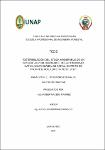| dc.contributor.advisor | Rodríguez Gómez, Jorge Luis | |
| dc.contributor.author | Macedo Ramirez, Alexander | |
| dc.date.accessioned | 2022-05-27T16:05:51Z | |
| dc.date.available | 2022-05-27T16:05:51Z | |
| dc.date.issued | 2022 | |
| dc.identifier.uri | https://hdl.handle.net/20.500.12737/8031 | |
| dc.description.abstract | The research was carried out in the forests of the native community "Santa Isabel de Copal" located in the Loreto region. The main objective was to provide qualitative, quantitative, economic information and uses of commercial timber species. The population. With a total area (ha): 801 of the Flooded Alluvial Forest. The sample. It was 621.04 ha of the 02 annual operating plan of the Santa Isabel de Copal native community, Trompeteros district, Loreto Peru. The methodology used to carry out the fieldwork was the design of a stratified systematic inventory (by type of forest) with rectangular sampling units or plots of 0.5 ha of surface (500m x 10m), to evaluate the individuals with diameters greater than 40 cm DBH. With 62 sampling units 11 commercial species belonging to 7 botanical families were found. Finding The largest number of species is in the botanical family Fabaceae with 4 species, followed by the Myristicaceae with 2 species. The abundance of commercial species is in the Fabaceae family, which represents 36% and 18%, followed by the other species with 9% of the total species registered in the forest inventory of the study area. The dominance of the commercial species was 2 063 m2 / ha. The most frequent species are "cachimbo, capiruri, capirona". The representative species, according to the IVI are, "capirona, capinuri, cachimbo and cumala". The volume of commercial wood was 13,679 m3 / ha. The potential use of the identified species is: sawmill construction, parquet, laminate, Shingles and furniture. The species with the highest Valuation per hectare is the lupuna with S /. 848 871,744 soles. | en_US |
| dc.description.abstract | La investigación se desarrolló en los bosques de la comunidad nativa “Santa Isabel de Copal” ubicado en región Loreto. El objetivo principal fue, proporcionar información cualitativa, cuantitativa, económica y usos de las especies comerciales maderables. La población. Con un área total (ha): 801 del Bosque Aluvial Inundable. La muestra. Fue de 621.04 ha del plan operativo anual 02 de la comunidad nativa Santa Isabel de Copal, distrito de Trompeteros, Loreto Perú. La metodología que se empleó para hacer el trabajo de campo, fue el diseño de un inventario sistemático estratificado (por tipo de bosque) con unidades o parcelas de muestreo rectangulares de 0.5 ha de superficie (500m x 10m), para evaluar los individuos con diámetros superiores a 40 cm de DAP. Con 62 unidades de muestreo. Se encontró 11 especies comerciales pertenecientes a 7 familias botánicas. Encontrando El mayor número de especies está en la familia botánica Fabaceae con 4 especies, seguido de la Myristicaceae con 2 especies. La abundancia de las
especies comerciales está en la familia Fabaceae que representa el 36 % y 18 % seguidos de las demás especies con 9% del total de especies registradas en el inventario forestal del área de estudio. La dominancia de las especies comerciales fue 2 063 m2 / ha. Las especies de mayor frecuencia son “cachimbo, capiruri, capirona”. Las especies representativas, según el IVI son, “capirona, capinuri, cachimbo y cumala”. El volumen de madera comercial fue de 13.679 m3 / ha. El uso potencial de las especies identificadas es: aserrío, construcción, parquet, laminado, Tablillas y mueblería. Las especies con mayor Valorización por hectárea es la lupuna con S/. 848 871.744 soles. | es_PE |
| dc.format | application/pdf | es_PE |
| dc.language.iso | spa | es_PE |
| dc.publisher | Universidad Nacional de la Amazonía Peruana | es_PE |
| dc.rights | info:eu-repo/semantics/openAccess | * |
| dc.rights.uri | https://creativecommons.org/licenses/by/4.0/ | * |
| dc.subject | Árboles maderables | es_PE |
| dc.subject | Existencia | es_PE |
| dc.subject | Bosque tropical | es_PE |
| dc.subject | Suelo aluvial | es_PE |
| dc.title | Determinación del stock maderable de un bosque aluvial inundable de la comunidad nativa Santa Isabel de Copal, distrito de Trompeteros, Loreto Perú. 2019 | es_PE |
| dc.type | info:eu-repo/semantics/bachelorThesis | es_PE |
| thesis.degree.discipline | Ingeniería Forestal | es_PE |
| thesis.degree.grantor | Universidad Nacional de la Amazonía Peruana. Facultad de Ciencias Forestales | es_PE |
| thesis.degree.name | Ingeniero(a) Forestal | es_PE |
| dc.subject.ocde | https://purl.org/pe-repo/ocde/ford#4.01.02 | es_PE |
| renati.author.dni | 46022376 | |
| renati.advisor.orcid | https://orcid.org/0000-0002-9511-2501 | |
| renati.advisor.dni | 5229768 | |
| renati.type | https://purl.org/pe-repo/renati/type#tesis | es_PE |
| renati.discipline | 821046 | es_PE |
| renati.level | https://purl.org/pe-repo/renati/level#tituloProfesional | es_PE |
| renati.juror | Escobar Diaz, José Antonio | |
| renati.juror | Maury Laura, Ángel Eduardo | |
| renati.juror | Rojas Tuanama, Rildo | |
| dc.publisher.country | PE | es_PE |


